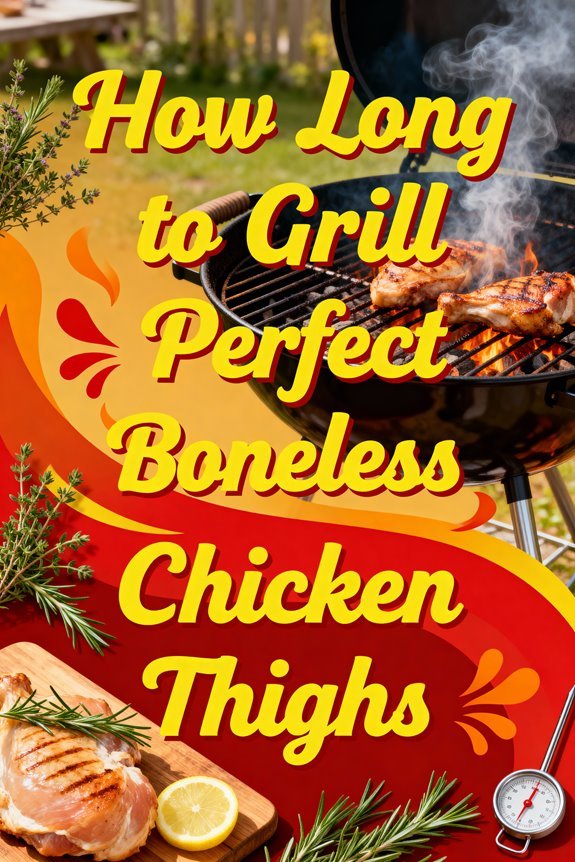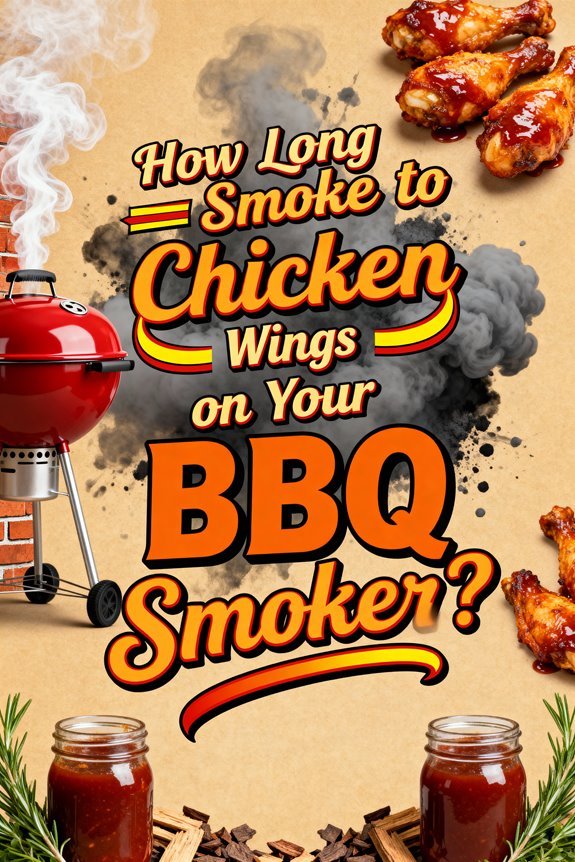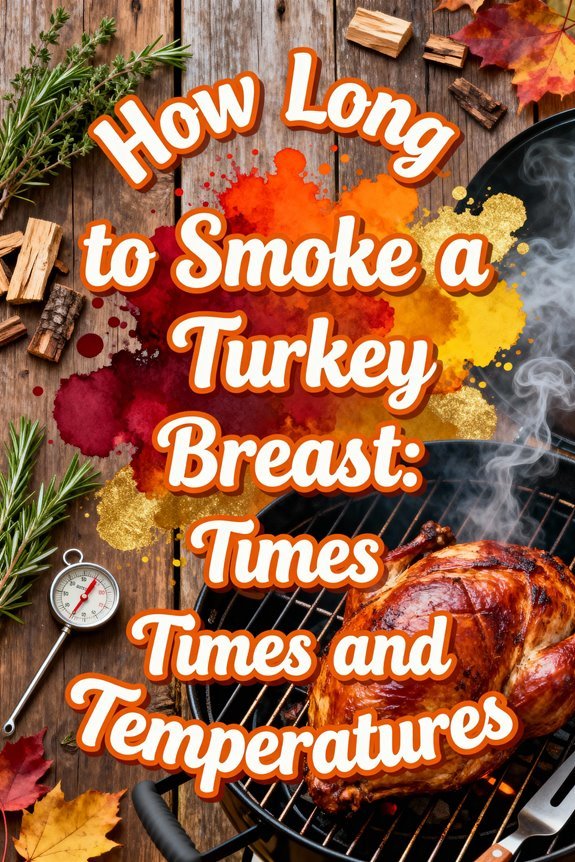You’ll need 3.5 to 4.5 hours to smoke a 4-pound whole chicken at 225°F, using roughly 35 minutes per pound as your baseline. However, don’t rely solely on time—always use a digital probe thermometer to monitor internal temperature. Your chicken’s done when the breast reaches 160-165°F and thighs hit 170-175°F. Remove it at 155-160°F to account for carryover cooking during the 15-20 minute rest period. Master these fundamentals, and you’ll uncover techniques that transform ordinary smoked chicken into restaurant-quality results.
Smoking Time Guidelines for a 4-Pound Chicken at 225°F
Smoking a 4-pound whole chicken at 225°F takes between 3.5 to 4.5 hours, though you’ll want to rely on internal temperature rather than time alone. The standard calculation of 35 minutes per pound provides a useful baseline for smoking duration tips, but variables like smoker type and ambient conditions affect actual cooking time. Your chicken weight considerations should account for whether the bird is fully thawed and cavity-emptied, as these factors directly impact heat penetration. Similar to grilling chicken, patting dry the skin before seasoning helps achieve better results. Start monitoring breast temperature at the 3-hour mark, targeting 160-165°F, while thighs should reach 170-175°F. Use a digital probe thermometer inserted into the thickest portions for accuracy. After reaching the target temperature, let it rest for 5-10 minutes to ensure optimal juiciness. Temperature trumps timing—always verify doneness internally before removing from the smoker. Experimenting with different seasoning options allows you to discover personal flavor preferences that complement the natural smokiness of the chicken.
Preparing Your Whole Chicken Before Smoking
Proper preparation directly determines your smoked chicken’s final quality, starting with the bird itself. Remove giblets, pat the chicken thoroughly dry with paper towels, and let it reach room temperature for 20-30 minutes. These cleaning techniques guarantee better smoke adhesion and crispier skin. Similar to turkey breast smoking, applying a thin coat of mayo or butter helps maintain moisture throughout the cooking process.
Consider brining methods to enhance moisture retention. Wet brining requires submerging the chicken in ½ cup salt per gallon of water for 4-24 hours, while dry brining involves rubbing salt directly on the bird and refrigerating uncovered for 8-24 hours. Letting chicken sit with seasoning enhances flavor through a process similar to dry-brining.
Apply your dry rub generously to all surfaces, including the cavity. For optimal results like with turkey, smoking the bird breast side down helps keep the meat juicy. Tie the legs together, tuck wing tips under, and insert a probe thermometer into the thickest breast portion without touching bone for accurate temperature monitoring.
Essential Smoker Setup and Temperature Control
Your prepared chicken won’t deliver the results you’re expecting without a properly configured smoker running at the right temperature. Start with smoker maintenance—clean grates and ash pans prevent temperature disruptions. Preheat to 225°F with your chosen wood already loaded, keeping the lid closed. Position racks centrally for ideal smoke circulation and add a water pan to stabilize heat and humidity. Unlike cast iron cooking which requires very high heat, smoking demands lower, steady temperatures.
Insert your digital thermometer probe into the thickest part of the breast or thigh, then close the lid and leave it closed. Airflow management is critical—adjust vents and dampers to control combustion rate, not the lid. Each opening causes significant heat loss. Monitor continuously, aiming for thin blue smoke rather than thick white billows that create bitterness. Just like with low and slow brisket smoking, patience and precise temperature control are essential for the best results. Expect the temperature to dip when placing the chicken in the smoker, which is normal as the cold meat absorbs heat.
Choosing the Right Wood for Smoking Chicken
The wood you select shapes your smoked chicken’s flavor as much as temperature and time combined. For whole birds, you’ll want milder woods that enhance rather than overpower. Apple and cherry deliver sweet, fruity notes that complement chicken’s natural taste, while maple adds subtle sweetness perfect for longer smoking sessions. Pecan offers a nutty, earthy dimension popular in Southern traditions. If you’re craving bold smoke, hickory provides robust intensity—just use it sparingly to avoid bitterness. Oak stands as your versatile middle ground, burning consistently throughout extended cooks. Understanding these flavor profiles lets you create wood combinations that layer complexity: try mixing fruit woods with pecan for balanced sweetness and nuttiness, or blend oak with hickory for controlled strength. Start with a handful of wood chips or 1-2 chunks depending on your smoker’s size to maintain a consistent stream of smoke without overwhelming the chicken’s delicate flavor. These wood choices paired with low temperature cooking at 225°F will develop that deep, smoky flavor over the 1-2 hour smoking process. Quality wood pellet blends from trusted brands like Traeger and Camp Chef ensure reliable smoke production throughout your cook.
Monitoring Internal Temperature for Perfect Doneness
Once you’ve selected your wood and started the smoking process, temperature becomes your primary guide to perfectly cooked chicken. You’ll need reliable digital thermometers—preferably wireless probes that remain inserted during cooking. Insert one probe into the thickest part of the breast without touching bone, and another into the thigh near the bone. These cooking techniques guarantee accurate readings across different meat types. Oak and hickory woods provide excellent complementary flavors without overwhelming the meat.
Your breast target is 160-165°F, while thighs require 170-175°F for ideal tenderness. Remove the chicken at 155-160°F to account for carryover cooking, which raises internal temperature 5-10°F during the 10-15 minute rest period. Brining or marinating can help lock in moisture and enhance the final flavor. Temperature monitoring becomes critical during the final hour. Don’t rely solely on time estimates—probe readings determine true doneness and prevent overcooking. Plan for approximately 3 hours total smoking time when maintaining consistent smoker temperatures of 225° and 275°.
Flavoring and Seasoning Techniques for Smoked Chicken
Transforming a simple bird into restaurant-quality smoked chicken hinges on your seasoning strategy. Master rub application techniques by combining brown sugar, smoked paprika, chili powder, cumin, garlic powder, and chipotle into a balanced blend. Press the mixture gently into every crevice, working under the skin for direct meat contact without tearing. Let it rest 2-24 hours for ideal dry brining.
For deeper flavor infusion methods, inject phosphate-enriched brine containing dissolved seasonings directly into the breast and thighs. This delivers moisture and taste where rubs can’t reach. Pair injections with surface seasoning for layered complexity. Start with proper airflow control by adjusting your grill vents to maintain consistent temperatures throughout the smoking process. Consider spraying with apple cider vinegar during smoking to keep the meat moist and flavorful.
Customize your profile with thyme, rosemary, onion powder, and cayenne based on preference. The brown sugar caramelizes during smoking, creating appealing color while balancing savory heat elements. Pat the chicken dry before applying your rub to remove excess moisture and ensure better spice adhesion to the surface.
The Two-Stage Temperature Method for Crispy Skin
Perfect seasoning sets the foundation, but smoking technique determines whether you’ll bite into rubbery, steamed skin or the crackling texture that defines exceptional smoked chicken. The two stage method solves this challenge by separating flavor infusion from skin crisping. Start at 225-250°F for approximately one hour, allowing smoke to penetrate the meat while it cooks slowly. Once you’ve achieved sufficient smokiness, crank your smoker to 375°F. This temperature control shift transforms the skin from soft to crispy without overcooking the meat. Monitor internal temperatures with a probe thermometer throughout both stages—you’re targeting 165°F in the breast and 175°F in the thighs. The higher finishing temperature renders fat beneath the skin while creating that essential crispy skin everyone craves. If the chicken browns too quickly during the high-heat stage, shield with foil to prevent burning while the meat finishes cooking. For enhanced flavor profiles, try using fruit wood pellets like apple or cherry, which add a subtle sweetness to your smoked chicken. Many pitmasters recommend brining beforehand to ensure maximum juiciness in your finished bird.
Spatchcocking Benefits for Faster and Even Cooking
While traditional whole chicken smoking delivers excellent flavor, spatchcocking transforms your cook from a four-hour commitment to a two-hour achievement without sacrificing quality. The spatchcocking advantages are substantial: you’ll cut cooking time by approximately 25% while ensuring even heat distribution across the entire bird. The flattened shape eliminates hot and cold spots that plague whole chickens, preventing overcooked breasts and undercooked thighs.
Similar to smoked turkey, the technique promotes stable internal temperatures as the meat cooks evenly throughout. You’ll also gain superior smoke penetration through the exposed cavity, creating consistent flavor throughout. The cooking efficiency extends beyond time savings—no trussing required, and the uniform thickness means your target internal temperature arrives simultaneously across all sections. Removing the backbone allows the chicken to lay completely flat, maximizing surface contact with heat and smoke. This technique delivers crispy skin, moist meat, and that deep smoke profile you’re after, all in half the time. For optimal results, use a meat thermometer to ensure the chicken reaches 165°F in all parts.
Resting Your Smoked Chicken After Cooking
After you pull that perfectly smoked chicken from the grill, the most vital step isn’t carving—it’s waiting. Resting benefits your bird by allowing contracted muscle fibers to relax and reabsorb the juices forced out during cooking. This important period guarantees superior moisture retention and tenderness throughout every bite. Just as with flank steak preparation, proper resting ensures maximum juiciness and optimal texture in your finished dish.
Rest your whole smoked chicken for 15-20 minutes at room temperature. Place it on a cutting board loosely tented with foil—never wrapped tightly, which softens that crispy skin you worked hard to achieve. The internal temperature should read 165°F when removed, and carryover cooking will finish the process perfectly. For extra crispy skin, you can raise smoker temperature to 375-400°F for the final 10-15 minutes of cooking.
During rest, temperature gradients equalize and proteins help lock moisture inside. You can expect a temperature rise of 0-5°F as the chicken continues to cook slightly during this resting period. Skip this step and you’ll watch valuable juices flood your cutting board instead of staying where they belong.
Common Mistakes to Avoid When Smoking Chicken
Even experienced pitmasters sabotage their smoked chicken by treating it like brisket—and that’s the fastest path to leathery, dried-out poultry. Unlike tough cuts requiring “low and slow,” smoking chicken below 225°F extends cook time unnecessarily, drying the skin through excessive air flow. You’ll compound this error by skipping the brine and failing to dry the skin before seasoning, which prevents both flavor infusion and crispness. Never rely on time estimates alone—use a meat thermometer and pull chicken at 165°F internal temperature, not beyond. Pellet smokers’ built-in fans accelerate overcooking at low temps. Split the chicken along the backbone for even heat distribution and superior seasoning penetration. Pay careful attention to thinner sections like wings and breast ends, as these cook faster than thicker portions and risk becoming leathery if not monitored closely. Finally, maintain moisture with a water pan or spritz to balance smoke exposure against surface drying. For optimal results, consider increasing temperature to 275 to 300°F which provides better skin texture while reducing cook time significantly. Much like with turkey, resting after cooking helps redistribute the meat’s juices for better moisture retention when carving.







